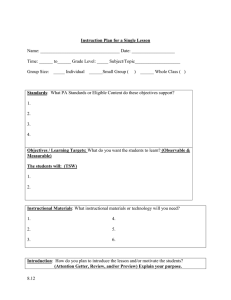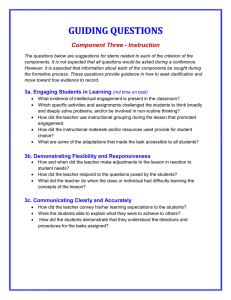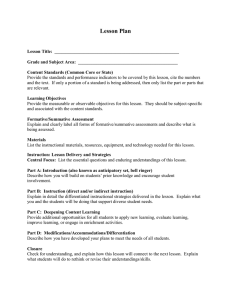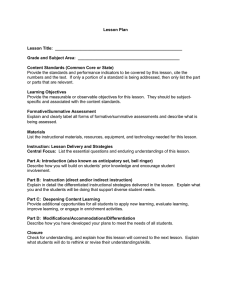FIP Alignment to TKES - Georgia Department of Education
advertisement
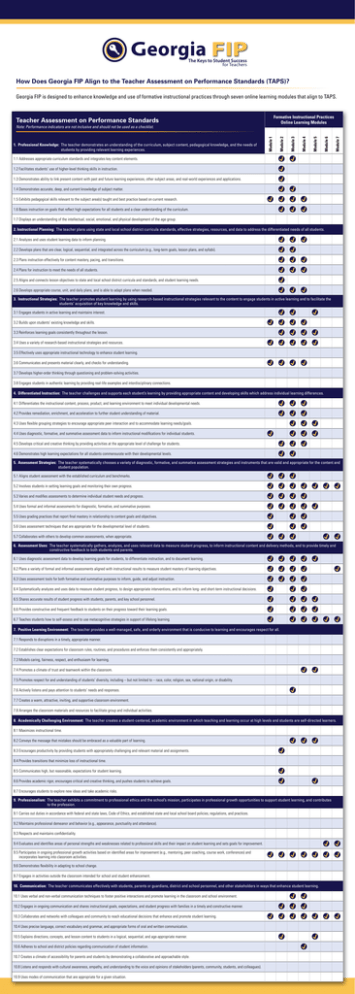
for Teachers How Does Georgia FIP Align to the Teacher Assessment on Performance Standards (TAPS)? Georgia FIP is designed to enhance knowledge and use of formative instructional practices through seven online learning modules that align to TAPS. Module 7 Module 6 Module 5 Module 4 Module 3 1. Professional Knowledge: T he teacher demonstrates an understanding of the curriculum, subject content, pedagogical knowledge, and the needs of students by providing relevant learning experiences. Module 1 Note: Performance indicators are not inclusive and should not be used as a checklist. Module 2 Formative Instructional Practices Online Learning Modules Teacher Assessment on Performance Standards 1.1 Addresses appropriate curriculum standards and integrates key content elements. 1.2 Facilitates students’ use of higher-level thinking skills in instruction. 1.3 Demonstrates ability to link present content with past and future learning experiences, other subject areas, and real-world experiences and applications. 1.4 Demonstrates accurate, deep, and current knowledge of subject matter. 1.5 Exhibits pedagogical skills relevant to the subject area(s) taught and best practice based on current research. 1.6 Bases instruction on goals that reflect high expectations for all students and a clear understanding of the curriculum. 1.7 Displays an understanding of the intellectual, social, emotional, and physical development of the age group. 2. Instructional Planning: T he teacher plans using state and local school district curricula standards, effective strategies, resources, and data to address the differentiated needs of all students. 2.1 Analyzes and uses student learning data to inform planning. 2.2 Develops plans that are clear, logical, sequential, and integrated across the curriculum (e.g., long-term goals, lesson plans, and syllabi). 2.3 Plans instruction effectively for content mastery, pacing, and transitions. 2.4 Plans for instruction to meet the needs of all students. 2.5 Aligns and connects lesson objectives to state and local school district curricula and standards, and student learning needs. 2.6 Develops appropriate course, unit, and daily plans, and is able to adapt plans when needed. 3. Instructional Strategies: The teacher promotes student learning by using research-based instructional strategies relevant to the content to engage students in active learning and to facilitate the students’ acquisition of key knowledge and skills. 3.1 Engages students in active learning and maintains interest. 3.2 Builds upon students’ existing knowledge and skills. 3.3 Reinforces learning goals consistently throughout the lesson. 3.4 Uses a variety of research-based instructional strategies and resources. 3.5 Effectively uses appropriate instructional technology to enhance student learning. 3.6 Communicates and presents material clearly, and checks for understanding. 3.7 Develops higher-order thinking through questioning and problem-solving activities. 3.8 Engages students in authentic learning by providing real-life examples and interdisciplinary connections. 4. Differentiated Instruction: The teacher challenges and supports each student’s learning by providing appropriate content and developing skills which address individual learning differences. 4.1 Differentiates the instructional content, process, product, and learning environment to meet individual developmental needs. 4.2 Provides remediation, enrichment, and acceleration to further student understanding of material. 4.3 Uses flexible grouping strategies to encourage appropriate peer interaction and to accommodate learning needs/goals. 4.4 Uses diagnostic, formative, and summative assessment data to inform instructional modifications for individual students. 4.5 Develops critical and creative thinking by providing activities at the appropriate level of challenge for students. 4.6 Demonstrates high learning expectations for all students commensurate with their developmental levels. 5. Assessment Strategies: The teacher systematically chooses a variety of diagnostic, formative, and summative assessment strategies and instruments that are valid and appropriate for the content and student population. 5.1 Aligns student assessment with the established curriculum and benchmarks. 5.2 Involves students in setting learning goals and monitoring their own progress. 5.3 Varies and modifies assessments to determine individual student needs and progress. 5.4 Uses formal and informal assessments for diagnostic, formative, and summative purposes. 5.5 Uses grading practices that report final mastery in relationship to content goals and objectives. 5.6 Uses assessment techniques that are appropriate for the developmental level of students. 5.7 Collaborates with others to develop common assessments, when appropriate. 6. Assessment Uses: T he teacher systematically gathers, analyzes, and uses relevant data to measure student progress, to inform instructional content and delivery methods, and to provide timely and constructive feedback to both students and parents. 6.1 Uses diagnostic assessment data to develop learning goals for students, to differentiate instruction, and to document learning. 6.2 Plans a variety of formal and informal assessments aligned with instructional results to measure student mastery of learning objectives. 6.3 Uses assessment tools for both formative and summative purposes to inform, guide, and adjust instruction. 6.4 Systematically analyzes and uses data to measure student progress, to design appropriate interventions, and to inform long- and short-term instructional decisions. 6.5 Shares accurate results of student progress with students, parents, and key school personnel. 6.6 Provides constructive and frequent feedback to students on their progress toward their learning goals. 6.7 Teaches students how to self-assess and to use metacognitive strategies in support of lifelong learning. 7. Positive Learning Environment: The teacher provides a well-managed, safe, and orderly environment that is conducive to learning and encourages respect for all. 7.1 Responds to disruptions in a timely, appropriate manner. 7.2 Establishes clear expectations for classroom rules, routines, and procedures and enforces them consistently and appropriately. 7.3 Models caring, fairness, respect, and enthusiasm for learning. 7.4 Promotes a climate of trust and teamwork within the classroom. 7.5 Promotes respect for and understanding of students’ diversity, including – but not limited to – race, color, religion, sex, national origin, or disability. 7.6 Actively listens and pays attention to students’ needs and responses. 7.7 Creates a warm, attractive, inviting, and supportive classroom environment. 7.8 Arranges the classroom materials and resources to facilitate group and individual activities. 8. Academically Challenging Environment: The teacher creates a student-centered, academic environment in which teaching and learning occur at high levels and students are self-directed learners. 8.1 Maximizes instructional time. 8.2 Conveys the message that mistakes should be embraced as a valuable part of learning. 8.3 Encourages productivity by providing students with appropriately challenging and relevant material and assignments. 8.4 Provides transitions that minimize loss of instructional time. 8.5 Communicates high, but reasonable, expectations for student learning. 8.6 Provides academic rigor, encourages critical and creative thinking, and pushes students to achieve goals. 8.7 Encourages students to explore new ideas and take academic risks. 9. Professionalism: T he teacher exhibits a commitment to professional ethics and the school’s mission, participates in professional growth opportunities to support student learning, and contributes to the profession. 9.1 Carries out duties in accordance with federal and state laws, Code of Ethics, and established state and local school board policies, regulations, and practices. 9.2 Maintains professional demeanor and behavior (e.g., appearance, punctuality and attendance). 9.3 Respects and maintains confidentiality. 9.4 Evaluates and identifies areas of personal strengths and weaknesses related to professional skills and their impact on student learning and sets goals for improvement. 9.5 Participates in ongoing professional growth activities based on identified areas for improvement (e.g., mentoring, peer coaching, course work, conferences) and incorporates learning into classroom activities. 9.6 Demonstrates flexibility in adapting to school change. 9.7 Engages in activities outside the classroom intended for school and student enhancement. 10. Communication: The teacher communicates effectively with students, parents or guardians, district and school personnel, and other stakeholders in ways that enhance student learning. 10.1 Uses verbal and non-verbal communication techniques to foster positive interactions and promote learning in the classroom and school environment. 10.2 Engages in ongoing communication and shares instructional goals, expectations, and student progress with families in a timely and constructive manner. 10.3 Collaborates and networks with colleagues and community to reach educational decisions that enhance and promote student learning. 10.4 Uses precise language, correct vocabulary and grammar, and appropriate forms of oral and written communication. 10.5 Explains directions, concepts, and lesson content to students in a logical, sequential, and age-appropriate manner. 10.6 Adheres to school and district policies regarding communication of student information. 10.7 Creates a climate of accessibility for parents and students by demonstrating a collaborative and approachable style. 10.8 Listens and responds with cultural awareness, empathy, and understanding to the voice and opinions of stakeholders (parents, community, students, and colleagues). 10.9 Uses modes of communication that are appropriate for a given situation.

